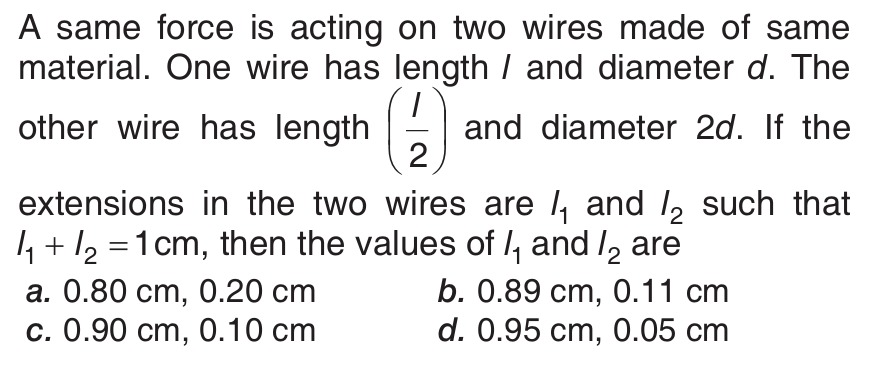Question
Question: A same force is acting on two wires made of same material. One wire has length $l$ and diameter $d$....
A same force is acting on two wires made of same material. One wire has length l and diameter d. The other wire has length (2l) and diameter 2d. If the extensions in the two wires are l1 and l2 such that l1+l2=1cm, then the values of l1 and l2 are

0.80 cm, 0.20 cm
0.89 cm, 0.11 cm
0.90 cm, 0.10 cm
0.95 cm, 0.05 cm
0.89 cm, 0.11 cm
Solution
The extension ΔL of a wire under a force F is given by the formula derived from Young's Modulus:
Y=StrainStress=ΔL/LF/A
Rearranging for ΔL, we get:
ΔL=AYFL
where L is the original length, A is the cross-sectional area, and Y is Young's modulus of the material.
The cross-sectional area of a wire with diameter d is A=π(d/2)2=4πd2.
So, the extension can be written as:
ΔL=(πd2/4)YFL=πd2Y4FL
For the first wire:
Length L1=l Diameter d1=d Extension ΔL1=l1
Since the material is the same, Young's modulus Y1=Y. The force is the same, F1=F.
l1=πd2Y4Fl
For the second wire:
Length L2=l/2 Diameter d2=2d Extension ΔL2=l2
Material is the same, Y2=Y. Force is the same, F2=F.
l2=π(2d)2Y4F(l/2)=π(4d2)Y4Fl/2=4πd2Y2Fl=2πd2YFl
Now, let's find the ratio of the extensions l1 and l2:
l2l1=2πd2YFlπd2Y4Fl
l2l1=πd2Y4Fl×Fl2πd2Y
l2l1=14×2=8
So, l1=8l2.
We are given that the sum of the extensions is 1 cm:
l1+l2=1 cm
Substitute l1=8l2 into the sum equation:
8l2+l2=1 9l2=1 l2=91 cm
Now find l1 using l1=8l2:
l1=8×91=98 cm
The exact values are l1=98 cm and l2=91 cm.
Let's convert these to decimal values:
l1=98≈0.888... cm l2=91≈0.111... cm
Comparing these values with the given options, option (b) provides values 0.89 cm and 0.11 cm. These are the values of 8/9 and 1/9 rounded to two decimal places. 0.89+0.11=1.00 cm (Matches the sum) 0.89/0.11≈8.09 (Close to the calculated ratio 8, the difference is due to rounding).
Thus, the values of l1 and l2 are approximately 0.89 cm and 0.11 cm.
